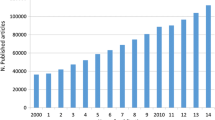Abstract
Prognostic studies examine the effect of variables, like surgical interventions , on disease progression. When posed with a clinical question around outcomes and prognosis , clinicians need to know how to best answer it by searching the literature. Prognostic studies can have a variety of designs; the optimal design depends on the question posed. Generally, observational studies provide the highest confidence in estimates for prognosis. The evaluation of a prognostic study hinges on six questions: (1) Is the sample representative of my patient? (2) Is the follow-up sufficiently long and complete? (3) Are the assessed outcomes objective and unbiased? (4) How likely are the outcomes to occur over time? (5) How precise are the estimates? and (6) Can I apply the results to my practice or patient? Using a clinical example, this chapter demonstrates how to identify and appraise prognostic literature by answering each question.
Access this chapter
Tax calculation will be finalised at checkout
Purchases are for personal use only
Similar content being viewed by others
References
Moons KGM, Vergouwe Y, Grobbee DE, Altman DG. Prognosis and prognostic research: what, why, and how? BMJ. 2009;338:375.
Mack JW, Joffe S. Communicating about prognosis: ethical responsibilities of pediatricians and parents. Pediatrics. 2014;133(Suppl 1):S24–30.
Randolph AG, Guyatt GH, Richardson WS. Prognosis in the intensive care unit: finding accurate and useful estimates for counseling patients. Crit Care Med. 1998;26:767–72.
Italiano A. Prognostic or predictive? It’s time to get back to definitions! J Clin Oncol. 2011;29:4718; author reply 4718–9.
Barton S. Which clinical studies provide the best evidence? The best RCT still trumps the best observational study. BMJ. 2000;321:255–6.
Iorio A SF, Falavigna M. Use of GRADE for assessment of evidence about prognosis: rating confidence in estimates of event rates in broad categories of patients. BMJ. 2015;350.
Stassano P, Di Tommaso L, Monaco M, Iorio F, Pepino P, Spampinato N, et al. Aortic valve replacement: a prospective randomized evaluation of mechanical versus biological valves in patients ages 55 to 70 years. J Am Coll Cardiol. 2009;54:1862–8.
Hansebout RR, Cornacchi SD, Haines T, Goldsmith CH. How to use an article about prognosis. Can J Surg. 2009;52:328–36.
Gamble JM. An introduction to the fundamentals of cohort and case-control studies. Can J Hosp Pharm. 2014;67:366–72.
Berger ML, Dreyer N, Anderson F, Towse A, Sedrakyan A, Normand SL. Prospective observational studies to assess comparative effectiveness: the ISPOR good research practices task force report. Value Health. 2012;15:217–30.
Thiese MS. Observational and interventional study design types; an overview. Biochem Med (Zagreb). 2014;24:199–210.
Goldstone AB, Chiu P, Baiocchi M, Lingala B, Patrick WL, Fischbein MP, et al. Mechanical or biologic prostheses for aortic-valve and mitral-valve replacement. N Engl J Med. 2017;377:1847–57.
Mihailovic A, Bell CM, Urbach DR. Users’ guide to the surgical literature. Case-control studies in surgical journals. Can J Surg. 2005;48:148–51.
Sleder A, Tackett S, Cerasale M, Mittal C, Isseh I, Radjef R, et al. Socioeconomic and racial disparities: a case-control study of patients receiving transcatheter aortic valve replacement for severe aortic stenosis. J Racial Ethn Health Disparities. 2017;4:1189–94.
Song JW, Chung KC. Observational studies: cohort and case-control studies. Plast Reconstr Surg. 2010;126:2234–42.
Hansebout RR, Cornacchi SD, Haines T, Goldsmith CH. User’s guide to the surgical literature: how to use an article about prognosis. Can J Surg. 2009;52(4):328–36.
Banerjee A, Chaudhury S. Statistics without tears: populations and samples. Ind Psychiatry J. 2010;19:60–5.
Randolph AG CD, Guyatt G. Prognosis. In: Guyatt G, Rennie D, Meade MO, Cook DJ, editors. Users’ guides to the medical literature: a manual for evidence-based clinical practice. New York, NY: McGraw-Hill, 2018.
Farrokhyar F, Bajammal S, Kahnamoui K, Bhandari M. Practical tips for surgical research. Ensuring balanced groups in surgical trials. Can J Surg. 2010;53:418–23.
Christenfeld NJ, Sloan RP, Carroll D, Greenland S. Risk factors, confounding, and the illusion of statistical control. Psychosom Med. 2004;66:868–75.
Akl EA, Briel M, You JJ, Sun X, Johnston BC, Busse JW, et al. Potential impact on estimated treatment effects of information lost to follow-up in randomised controlled trials (LOST-IT): systematic review. BMJ. 2012;344:e2809.
Jaffer IH, Whitlock RP. A mechanical heart valve is the best choice. Heart Asia. 2016;8:62–4.
Cannegieter SC, Rosendaal FR, Wintzen AR, van der Meer FJ, Vandenbroucke JP, Briet E. Optimal oral anticoagulant therapy in patients with mechanical heart valves. N Engl J Med. 1995;333:11–7.
Carlson MD, Morrison RS. Study design, precision, and validity in observational studies. J Palliat Med. 2009;12:77–82.
Walton MK, Powers JH 3rd, Hobart J, Patric D, Marquis P, Vamvakas S, et al. Clinical outcome assessments: conceptual foundation-report of the ISPOR clinical outcomes assessment—emerging good practices for outcomes research task force. Value Health. 2015;18:741–52.
Russell SD, Saval MA, Robbins JL, Ellestad MH, Gottlieb SS, Handberg EM, et al. New York heart association functional class predicts exercise parameters in the current era. Am Heart J. 2009;158:S24–30.
Rich JT, Neely JG, Paniello RC, Voelker CC, Nussenbaum B, Wang EW. A practical guide to understanding Kaplan-Meier curves. Otolaryngol Head Neck Surg. 2010;143:331–6.
du Prel JB, Hommel G, Rohrig B, Blettner M. Confidence interval or p-value?: part 4 of a series on evaluation of scientific publications. Dtsch Arztebl Int. 2009;106:335–9.
Messe SR, Acker MA, Kasner SE, et al. Stroke after aortic valve surgery: results from a prospective cohort. Circulation. 2014;129:2253–61.
Gawande A. Two hundred years of surgery. N Engl J Med. 2012;366:1716–23.
Maganti M, Rao V, Brister S, Ivanov J. Decreasing mortality for coronary artery bypass surgery in octogenarians. Can J Cardiol. 2009;25:e32–5.
Author information
Authors and Affiliations
Corresponding author
Editor information
Editors and Affiliations
Rights and permissions
Copyright information
© 2019 Springer Nature Switzerland AG
About this chapter
Cite this chapter
Gupta, S., Kim, K., Belley-Côté, E., Whitlock, R.P. (2019). How to Assess a Prognostic Study. In: Thoma, A., Sprague, S., Voineskos, S., Goldsmith, C. (eds) Evidence-Based Surgery. Springer, Cham. https://doi.org/10.1007/978-3-030-05120-4_21
Download citation
DOI: https://doi.org/10.1007/978-3-030-05120-4_21
Published:
Publisher Name: Springer, Cham
Print ISBN: 978-3-030-05119-8
Online ISBN: 978-3-030-05120-4
eBook Packages: MedicineMedicine (R0)




